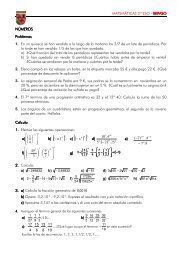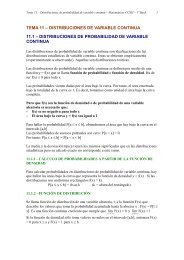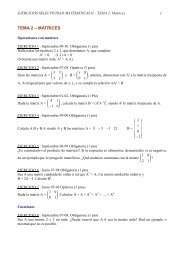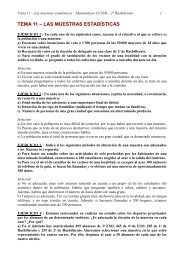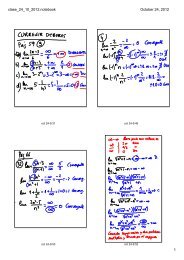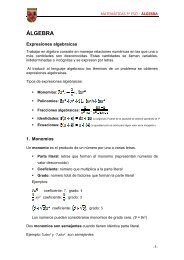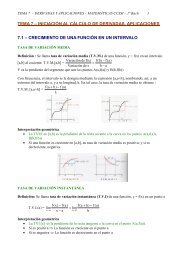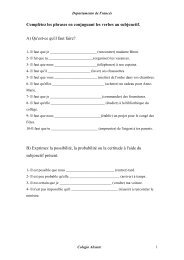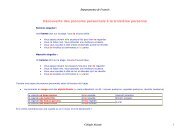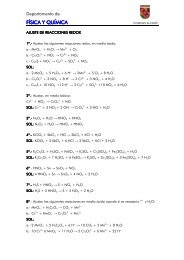TEMA 6 y 7 - RECTAS Y PLANOS EN EL ESPACIO ECUACIONES ...
TEMA 6 y 7 - RECTAS Y PLANOS EN EL ESPACIO ECUACIONES ...
TEMA 6 y 7 - RECTAS Y PLANOS EN EL ESPACIO ECUACIONES ...
You also want an ePaper? Increase the reach of your titles
YUMPU automatically turns print PDFs into web optimized ePapers that Google loves.
Temas 6 y 7 – Rectas y planos en el espacio- Matemáticas II – 2º Bachillerato 1<strong>TEMA</strong> 6 y 7 - <strong>RECTAS</strong> Y <strong>PLANOS</strong> <strong>EN</strong> <strong>EL</strong> <strong>ESPACIO</strong><strong>ECUACIONES</strong> DE LA RECTAPara hallar la ecuación de una recta en el espacio necesito:• Dos puntos• Un punto y su vector directorNota: Nosotros utilizaremos siempre un punto A(x 0 ,y 0 ,z 0 ) y un vector → v = (a,b,c).Si me dan dos puntos A(x 0 ,y 0 ,z 0 ), B(x 1 ,y 1 ,z 1 ) ⇒ Tomaremos uno de los mismos A(x 0 ,y 0 ,z 0 ) y comovector → →v = AB = (x 1 - x 0 , y 1 – y 0 , z 1 – z 0 )Ecuación vectorial: (x,y,z) = (x 0 ,y 0 ,z 0 ) + k.(a,b,c) ∀ k ∈ R⎧x= x0+ ka⎪Ecuaciones paramétricas: ⎨y= y0+ kb ∀ k ∈ R⎪⎩z= z0+ kcx − x0y − y0z − z0Ecuación continua: = =a b c⎧A1x+ B1y+ C1z+ D1= 0Ecuación implícita (como intersección de dos planos): ⎨⎩A2x+ B2y+ C2z+ D2= 0<strong>ECUACIONES</strong> DE UN PLANOPara hallar la ecuación de un plano en el espacio necesito:• Tres puntos• Un punto y dos vectores directoresNota: Nosotros utilizaremos siempre un punto A(x 0 ,y 0 ,z 0 ) y dos vectores → v 1 = (a 1 ,b 1 ,c 1 ), → v 2 = (a 2 ,b 2 ,c 2 )Si me dan tres puntos A(x 0 ,y 0 ,z 0 ), B(x 1 ,y 1 ,z 1 ), C(x 2 ,y 2 ,z 2 ) ⇒ Tomaremos uno de los mismos A(x 0 ,y 0 ,z 0 )→y como vectores → v 1 = AB = (x 1 - x 0 , y 1 – y 0 , z 1 – z 0 )→ →v 2 = AC = (x 2 - x 0 , y 2 – y 0 , z 2 – z 0 )Ecuación vectorial: (x,y,z) = (x 0 ,y 0 ,z 0 ) + s.(a 1 ,b 1 ,c 1 ) + t. (a 1 ,b 1 ,c 1 )⎧x= x0+ s.a1+ ta2⎪Ecuaciones paramétricas: ⎨y= y0+ s.b1+ tb2∀ s,t ∈ R⎪⎩z= z0+ s.c1+ tc2Ecuación implícita o general: Ax + By + Cz + D = 0x − x y − y z − zaa120bb120cc120= 0 ⇒ Ax + By + Cz + D = 0∀ s,t ∈ RVector normal = → n = (A,B,C) = → v 1 x → v 2 (Es perpendicular a los dos vectores directores)Nota: Si conocemos el vector normal y un punto podemos hallar directamente la ecuación general delplano. Del vector normal conocemos A, B y C ; y si sustituimos el punto hallamos D.
Temas 6 y 7 – Rectas y planos en el espacio- Matemáticas II – 2º Bachillerato 2POSICIONES R<strong>EL</strong>ATIVAS DE <strong>RECTAS</strong> Y <strong>PLANOS</strong>POSICIONES R<strong>EL</strong>ATIVAS DE DOS <strong>RECTAS</strong>Coincidentes Paralelas Secantes Se cruzanMétodo: Escribimos las ecuaciones paramétricas de cada una de ellas (con distinto parámetro), lasigualamos y resolvemos el sistema:• Sistema compatible determinado ⇒ Existe una única solución ⇒ Se cortan en un punto ⇒Secantes.• Sistema compatible indeterminado ⇒ Existen infinitas soluciones ⇒ Se cortan en infinitospuntos ⇒ Coincidentes.• Sistema incompatible ⇒ No existe solución ⇒ No se cortan ⇒ Paralelas o se cruzan.o Hallar el vector director de cada unao Si son paralelos (proporcionales) las rectas son paralelaso Si no son paralelos, las rectas se cruzan.POSICIONES R<strong>EL</strong>ATIVAS DE DOS <strong>PLANOS</strong>Coincidentes Paralelos SecantesMétodo: Escribimos las ecuaciones generales de cada uno de ellos y resolvemos el sistema:• Sistema compatible determinado ⇒ No puede ser• Sistema compatible indeterminado ⇒ Existen infinitas soluciones ⇒ Se cortan en infinitospuntos ⇒ Se cortan en un plano o en una rectao Si hay un grado de libertad ⇒ Un vector ⇒ Se cortan en una recta ⇒ Secanteso Si hay dos grados de libertad ⇒ Dos vectores ⇒ Se cortan en un plano ⇒ Coincidentes• Sistema incompatible ⇒ No existe solución ⇒ No se cortan ⇒ Paralelos.POSICIÓN R<strong>EL</strong>ATIVA <strong>EN</strong>TRE RECTA Y PLANORecta Contenida en el plano Secantes ParalelosEscribimos las ecuaciones paramétricas de la recta y la general del plano y resolvemos el sistema:• Sistema compatible determinado ⇒ Existe una única solución ⇒ Se cortan en un punto ⇒Secantes.• Sistema compatible indeterminado ⇒ Existen infinitas soluciones ⇒ Se cortan en infinitospuntos ⇒ Recta contenida en el plano.• Sistema incompatible ⇒ No existe solución ⇒ No se cortan ⇒ Paralelos.
Temas 6 y 7 – Rectas y planos en el espacio- Matemáticas II – 2º Bachillerato 3POSICIÓN R<strong>EL</strong>ATIVA DE TRES <strong>PLANOS</strong>Coincidentes Dos coincidente y Dos coincidentes y Paralelos Paralelosel otro secante el otro paraleloDos paralelos Secantes en una recta Secantes en un punto Secantes 2 a 2Y el otro secanteen una rectaEscribimos las ecuaciones de los tres planos en forma general y resolvemos el sistema:• Sistema compatible determinado ⇒ Existe una única solución ⇒ Se cortan en un punto• Sistema compatible indeterminado:o Un grado de libertad: Se cortan en una recta Dos planos coincidentes y el otro secante Los tres se cortan en una rectao Dos grados de libertad: Se cortan en un plano ⇒ Coincidentes• Sistema incompatible ⇒ No existe solucióno Dos coincidentes y el otro paraleloo Tres paraleloso Dos paralelos y el otro los cortao Se cortan dos a dos en una rectaÁNGULOSANGULO <strong>EN</strong>TRE DOS <strong>RECTAS</strong> Cos (r 1 ,r 2 ) = cos ( → v 1 , → v 2 ) =→→11→v . v→2v . v2ANGULO <strong>EN</strong>TRE DOS <strong>PLANOS</strong> Cos (Π 1 , Π 2 ) = cos( → n 1 , → n 2 ) =→n→n11→.n→. n22ÁNGULO <strong>EN</strong>TRE RECTA Y PLANO Sen (r, Π) = cos ( → v r , → n Π ) =→→rr→v .nv→. nππ
Temas 6 y 7 – Rectas y planos en el espacio- Matemáticas II – 2º Bachillerato 4DISTANCIA <strong>EN</strong>TRE PUNTOS, <strong>RECTAS</strong> Y <strong>PLANOS</strong>DISTANCIA <strong>EN</strong>TRE DOS PUNTOS: A(x 1 ,y 1 ,z 1 ) , B(x 2 ,y 2 ,z 2 )D(A,B) = |→22AB | = ( ) ( ) ( ) 2x2− x1+ y2− y1+ z2− z1DISTANCIA <strong>EN</strong>TRE UN PUNTO Y UNA RECTAD(P,r) =→r→vr→PP x vrDISTANCIA <strong>EN</strong>TRE UN PUNTO Y UN PLANO: P(x 0 ,y 0 ,z 0 ), Π: Ax + By + Cz + D = 0D(P, Π) =Ax0+ ByA20+ B+ Cz20+ C+ D2DISTANCIA <strong>EN</strong>TRE DOS <strong>RECTAS</strong>[ v ]r, vs, PrPsD(r,s) =vrx vsDISTANCIA <strong>EN</strong>TRE UNA RECTA Y UN PLANOD(r, Π) = d(P r , Π)DISTANCIA <strong>EN</strong>TRE DOS <strong>PLANOS</strong>D(Π 1 , Π 2 ) = d(P 1 , Π 2 )




